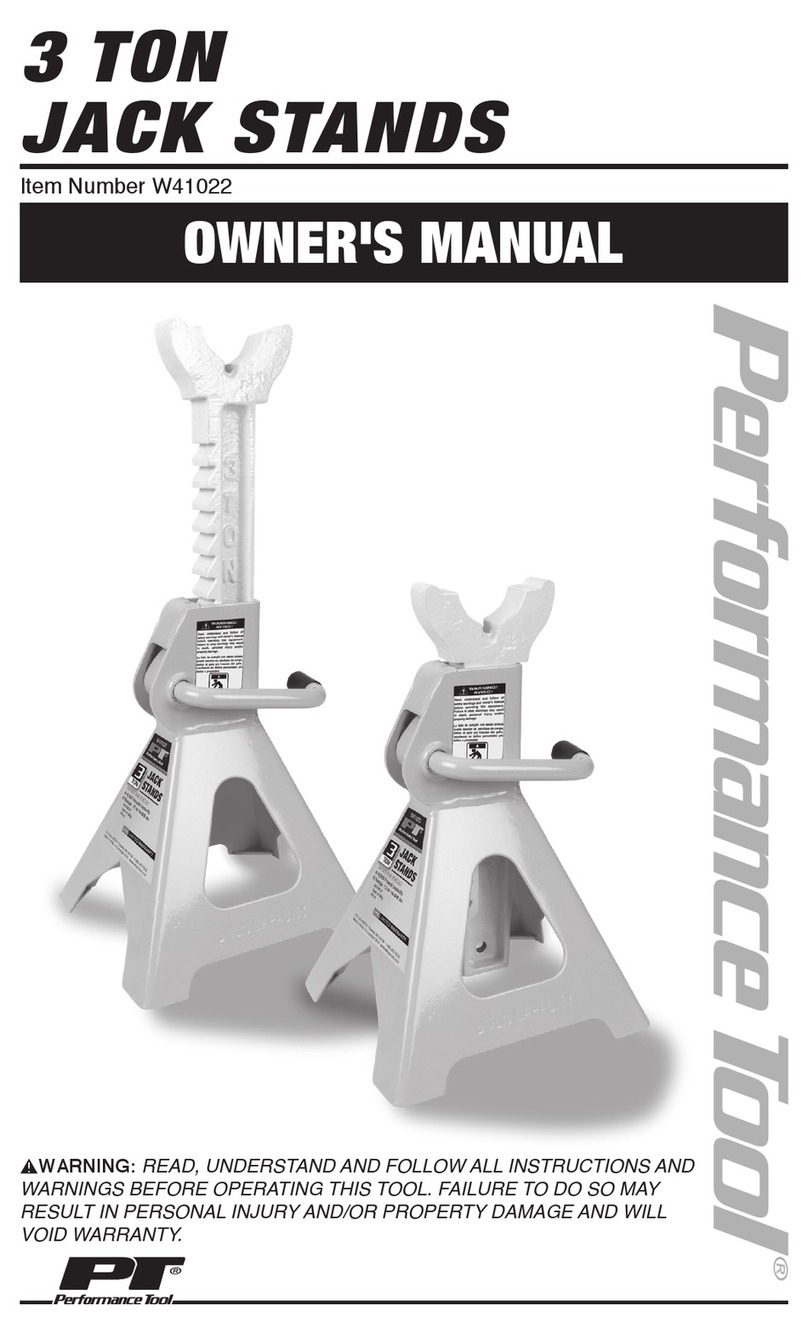Pittway SYSTEM SENSOR B501B User manual

D550-01-01 1 I56-310-03
B501B Plug-in Detector Base
For use with UL Listed detectors:
1551, 2551, 2551T, and 5551
INSTALLATION AND MAINTENANCE INSTRUCTIONS
A Division of Pittway
3825 Ohio Avenue, St. Charles, Illinois 60174
1-800-SENSOR2, FAX: 630-377-6495
Before Installing
Please thoroughly read the system wiring and installation
manual, and manual I56-407, Guide for Proper Use of Sys-
tem Smoke Detectors, which provides detailed information
on detector spacing, placement, zoning, and special appli-
cations. Copies of these manuals are available from System
Sensor or through a System Sensor distributor. (For installa-
tion in Canada, refer to CAN/ULC-S22524-M86, Standard
for the Installation of Fire Alarm Systems and CEC part 1,
Section 32.)
General Description
This plug-in detector base is used with System Sensor
model 1551 ionization, 2551 and 2551T photoelectronic,
and 5551 thermal detectors.
The B501B base is intended for use in a 2-wire intelligent
system, with screw terminals provided for power (+) and
(-), and remote annunciator connections. Communication
takes place over the power (+) and (-) lines. (See note on
page 4).
Specifications
Diameter: 6.1 inches (15.5 cm)
Mounting: 4 inch square box with or without plaster ring; Min. Depth: 1.5 inches.
4 inch Octagon Box; Min. Depth: 1.5 inches.
3-1/2 inch Octagon Box; Min. Depth: 1.5 inches.
Single Gang Box; Min. Depth: 1.5 inches.
Electrical Ratings
Voltage Range: 14.5 to 28 VDC peak
Standby Current (nominal): 150 µA at 24 VDC
Power-up Surge at Maximum
Rated Voltage: 1.5 mA-second
LED Current (nominal): 6 mA at 24 VDC
Base Terminals
NO. FUNCTION
1 POWER (-), REMOTE ANNUNCIATOR (-)
2 POWER (+)
3 REMOTE ANNUNCIATOR (+)
Figure 1. Terminal Layout
A78-1318-00
3
2
1
BASE
TERMINALS
TAMPER PROOF
TAB

D550-01-01 2 I56-310-03
Mounting
This detector base mounts directly to 3-1/2 inch and 4 inch
octagon boxes, 4 inch square boxes (with or without plas-
ter rings) and single gang boxes. To mount, remove decora-
tive ring by turning it in either direction to unhook the
snaps, then separate the ring from the base. Install the base
to the box using the screws supplied with the junction box
and the appropriate mounting slots in the base. Place deco-
rative ring onto base, then turn in either direction until the
ring snaps in place (see Figure 2).
Wiring Installation Guidelines
All wiring must be installed in compliance with the Na-
tional Electrical Code and the local authorities having juris-
diction. Proper wire gauges should be used. The
conductors used to connect smoke detectors to control pan-
els and accessory devices should be color-coded to prevent
wiring mistakes. Improper connections can prevent a sys-
tem from responding properly in the event of a fire.
For signal wiring (the wiring between interconnected de-
tectors or modules), it is recommended that the wire be no
smaller than 18 gauge (1.0 square mm). Wire sizes up to 12
gauge wire (2.5 square mm) may be used with the base.
For best system performance, the power (+) and power
(-) loop wires should be twisted pair installed in sepa-
rate grounded conduit to protect the loop from extrane-
ous electrical interference.
Wire connections are made by stripping about 3/8"of insu-
lation from the end of the wire (use strip gauge molded in
base), sliding the bare end of the wire under the clamping
plate, and tightening the clamping plate screw. Do not loop
the wire under the clamping plate.
The zone wiring of the detector base should be checked
before the detector heads are installed in them. The wiring
should be checked for continuity, polarity in the base, and
dielectric tests.
The base contains a label to write the zone, address, and
type of detector to be installed at that location. This infor-
mation is important to set the address of the detector head
that will later be plugged into the base and to verify the
type required for that location.
Figure 2. Mounting base to box:
A78-1175-13
SNAP ON
DECORATIVE
RING
SCREWS (NOT
SUPPLIED)
DETECTOR
BASE
BOX (NOT
SUPPLIED)

D550-01-01 3 I56-310-03
Tamper-proof Feature
This detector base also includes an optional tamper-proof
feature that, when activated, prevents removal of the detec-
tor without the use of a tool.
To activate this feature, simply break off the tab on the de-
tector base shown in Figure 4A, then install the detector. To
remove the detector from the base once the tamper-proof
feature has been activated, place a small bladed screw-
driver into the hole on the side of the base and push the
plastic lever away from the detector head (see Figure 4B).
This will allow the detector to be rotated counterclockwise
for removal.
32
1
32
1
32
1
+
-
-
+
U.L. LISTED COMPATIBLE
CONTROL PANEL
CLASS A OPTIONAL WIRING
REMOTE ANNUNCIATOR
+- CAUTION: Do not loop wire under terminal 1 or 2.
Break wire run to provide supervision of connections.
Figure 3. Typical wiring diagram for 2-wire loop:
A78-1253-00
PLASTIC LEVER
BREAK TAB AT
DOTTED LINE BY
TWISTING TOWARD
CENTER OF BASE.
USE SMALL-BLADED
SCREWDRIVER TO
PUSH PLASTIC LEVER
IN DIRECTION OF
ARROW.
Figure 4A. Activating tamper-proof feature: Figure 4B. Removing detector head from base:
A78-1175-03
NOTE: Head removal after the tamper-proof feature has
been activated first requires removal of the decora-
tive ring.
The tamper-proof feature may be defeated by breaking and
removing the plastic lever from the base. However, this pre-
vents ever using the feature again.
Remote Annunciator
The remote annunciator is connected between terminals 1
and 3 using the spade lug terminal packed with the remote
annunciator. The spade lug terminal is connected to the
base terminal as shown in Figure 5.

D550-01-01 4 I56-310-03
© System Sensor 1999
Three-Year Limited Warranty
System Sensor warrants its enclosed smoke detector base to be free from
defects in materials and workmanship under normal use and service for a
period of three years from date of manufacture. System Sensor makes no
other express warranty for this smoke detector base. No agent, representa-
tive, dealer, or employee of the Company has the authority to increase or
alter the obligations or limitations of this Warranty. The Company’s obli-
gation of this Warranty shall be limited to the repair or replacement of any
part of the smoke detector base which is found to be defective in materials
or workmanship under normal use and service during the three year pe-
riod commencing with the date of manufacture. After phoning System
Sensor’s toll free number 800-SENSOR2 (736-7672) for a Return Authori-
zation number, send defective units postage prepaid to: System Sensor,
Repair Department, RA #__________, 3825 Ohio Avenue, St. Charles, IL
60174. Please include a note describing the malfunction and suspected
cause of failure. The Company shall not be obligated to repair or replace
units which are found to be defective because of damage, unreasonable
use, modifications, or alterations occurring after the date of manufacture.
In no case shall the Company be liable for any consequential or incidental
damages for breach of this or any other Warranty, expressed or implied
whatsoever, even if the loss or damage is caused by the Company’s negli-
gence or fault. Some states do not allow the exclusion or limitation of inci-
dental or consequential damages, so the above limitation or exclusion may
not apply to you. This Warranty gives you specific legal rights, and you
may also have other rights which vary from state to state.
The smoke detector used with this base is designed to activate and ini-
tiate emergency action, but will do so only when it is used in conjunction
with an authorized fire alarm system. This detector must be installed in
accordance with NFPA standard 72.
Smoke detectors will not work without power. AC or DC powered
smoke detectors will not work if the power supply is cut off.
Smoke detectors will not sense fires which start where smoke does not
reach the detectors. Smoldering fires typically do not generate a lot of
heat which is needed to drive the smoke up to the ceiling where the
smoke detector is usually located. For this reason, there may be large de-
lays in detecting a smoldering fire with either an ionization type detector
or a photoelectric type detector. Either one of them may alarm only after
flaming has initiated which will generate the heat needed to drive the
smoke to the ceiling.
Smoke from fires in chimneys, in walls, on roofs or on the other side of a
closed door(s) may not reach the smoke detector and alarm it. A detector
cannot detect a fire developing on another level of a building quickly or at
all. For these reasons, detectors shall be located on every level and in
every bedroom within a building.
Smoke detectors have sensing limitations, too. Ionization detectors and
photoelectric detectors are required to pass fire tests of the flaming and
smoldering type. This is to ensure that both can detect a wide range of
types of fires. Ionization detectors offer a broad range of fire sensing capa-
bility but they are somewhat better at detecting fast flaming fires than
slow smoldering fires. Photoelectric detectors sense smoldering fires better
than flaming fires which have little, if any, visible smoke. Because fires de-
velop in different ways and are often unpredictable in their growth, nei-
ther type of detector is always best, and a given detector may not always
provide early warning of a specific type of fire.
In general, detectors cannot be expected to provide warnings for fires re-
sulting from inadequate fire protection practices, violent explosions, es-
caping gases which ignite, improper storage of flammable liquids like
cleaning solvents which ignite, other similar safety hazards, arson, smok-
ing in bed, children playing with matches or lighters, etc. Smoke detectors
used in high air velocity conditions may have a delay in alarm due to dilu-
tion of smoke densities created by frequent and rapid air exchanges. Addi-
tionally, high air velocity environments may create increased dust
contamination, demanding more frequent maintenance.
Smoke detectors cannot last forever. Smoke detectors contain electronic
parts. Even though smoke detectors are made to last over 10 years, any
part can fail at any time. Therefore, smoke detectors shall be replaced after
being in service for 10 years. The smoke detector system that this detector
is used in must be tested regularly per NFPA 72. This smoke detector
should be cleaned regularly per NFPA 72 or at least once a year.
WARNING
The Limitations of Property Protection Smoke Detectors
STRIPPED WIRE
WIRE WITH
SPADE LUG
A78-1473-00
Figure 5. Connection to remote annunciator terminal:It is not acceptable to have three stripped wires under the
same wiring terminal unless they are separated by a
washer or equivalent means. The spade lug supplied with
the remote annunciator is considered an equivalent means.
See Figure 5 for proper installation.
NOTE: System Sensor smoke detectors are marked with a
compatibility identifier located as the last digit of a
five digit code stamped on the back of the product.
Connect detectors only to compatible control units
as indicated in System Sensor’s compatibility chart
which contains a current list of U.L. listed control
units and detectors. A copy of this list is available
from System Sensor upon request.
Table of contents
Other Pittway Rack & Stand manuals
Popular Rack & Stand manuals by other brands

Realfiction
Realfiction Dreamoc user manual

Lightolier
Lightolier Brisa linear 3" bow surface installation instructions

Ashley
Ashley ASHDRMK-W Assembly and installation

Hanwha Techwin
Hanwha Techwin SBP-276HM quick start guide

Performance Tool
Performance Tool W41022 owner's manual

Argos
Argos 8754592 Assembly instructions

Bo-Camp
Bo-Camp 1694030 instruction manual

Middle Atlantic
Middle Atlantic WoodKit C3 Series instruction sheet

impact
impact LS-CS40M quick start guide

Solarbayer
Solarbayer PremiumPlan Mounting instruction

Vivo
Vivo STAND-V004FG instruction manual

Central Machinery
Central Machinery 42986 Assembly and operating instructions







